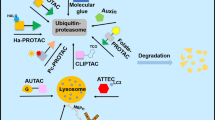Abstract.
To be, or not to be — that is the question not only for Hamlet in Shakespeare’s drama but also for a protein associated with molecular chaperones. While long viewed exclusively as cellular folding factors, molecular chaperones recently emerged as active participants in protein degradation. This places chaperones at the center of a life or death decision during protein triage. Here we highlight molecular mechanisms that underlie chaperone action at the folding/degradation interface in mammalian cells. We discuss the importance of chaperone-assisted degradation for the regulation of cellular processes and its emerging role as a target for therapeutic intervention in cancer and amyloid diseases.
Similar content being viewed by others
Author information
Authors and Affiliations
Corresponding author
Additional information
Received 16 April 2007; received after revision 10 May 2007; accepted 16 May 2007
Rights and permissions
About this article
Cite this article
Arndt, V., Rogon, C. & Höhfeld, J. To be, or not to be — molecular chaperones in protein degradation. Cell. Mol. Life Sci. 64, 2525 (2007). https://doi.org/10.1007/s00018-007-7188-6
Published:
DOI: https://doi.org/10.1007/s00018-007-7188-6




